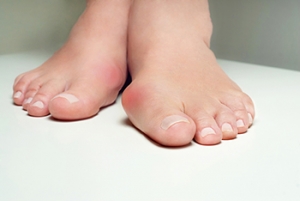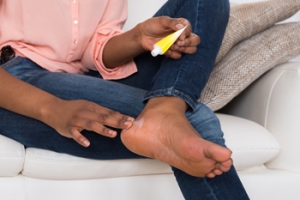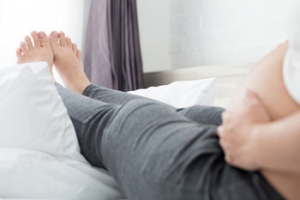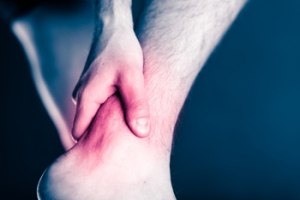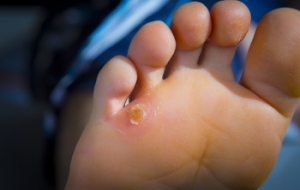
Bunions 101
 Bunions are a very common foot condition that develops at the main joint of the big toe and appears as a bony lump. Bunions are formed when the joint in the big toe gets pulled out of alignment and is turned towards the rest of the toes. Bunions can be formed due to a variety of factors that include a poor mechanical structure from genetics, footwear that fits poorly and is too narrow, age, or arthritis. Bunions can be painful and can interfere with wearing everyday footwear. Most treatments for bunions focus on relieving the pain caused by them, since surgery is the only option for correcting a bunion. Conservative or nonsurgical treatment options that a podiatrist may recommend include exercises, night splints, and shoe inserts. If you are struggling with a painful bunion, consulting with a podiatrist is suggested. A podiatrist will help you find a proper treatment method for managing the bunion and help determine if surgery is right for you.
Bunions are a very common foot condition that develops at the main joint of the big toe and appears as a bony lump. Bunions are formed when the joint in the big toe gets pulled out of alignment and is turned towards the rest of the toes. Bunions can be formed due to a variety of factors that include a poor mechanical structure from genetics, footwear that fits poorly and is too narrow, age, or arthritis. Bunions can be painful and can interfere with wearing everyday footwear. Most treatments for bunions focus on relieving the pain caused by them, since surgery is the only option for correcting a bunion. Conservative or nonsurgical treatment options that a podiatrist may recommend include exercises, night splints, and shoe inserts. If you are struggling with a painful bunion, consulting with a podiatrist is suggested. A podiatrist will help you find a proper treatment method for managing the bunion and help determine if surgery is right for you.
If you are suffering from bunion pain, contact one of our podiatrists of Princeton Foot and Ankle Associates. Our doctors can provide the care you need to keep you pain-free and on your feet.
What Is a Bunion?
Bunions are painful bony bumps that usually develop on the inside of the foot at the joint of the big toe. As the deformity increases over time, it may become painful to walk and wear shoes. Women are more likely to exacerbate existing bunions since they often wear tight, narrow shoes that shift their toes together. Bunion pain can be relieved by wearing wider shoes with enough room for the toes.
Causes
- Genetics – some people inherit feet that are more prone to bunion development
- Inflammatory Conditions - rheumatoid arthritis and polio may cause bunion development
Symptoms
- Redness and inflammation
- Pain and tenderness
- Callus or corns on the bump
- Restricted motion in the big toe
In order to diagnose your bunion, your podiatrist may ask about your medical history, symptoms, and general health. Your doctor might also order an x-ray to take a closer look at your feet. Nonsurgical treatment options include orthotics, padding, icing, changes in footwear, and medication. If nonsurgical treatments don’t alleviate your bunion pain, surgery may be necessary.
If you have any questions, please feel free to contact our offices located in Princeton, and West Windsor, NJ . We offer the newest diagnostic and treatment technologies for all your foot care needs.
What Are Bunions?
Bunions are large bony bumps at the base of the big toe. Medically known as hallux valgus, a bunion is a misalignment of the metatarsophalangeal joint, or big toe joint. The misalignment will generally worsen with time if left untreated.
The exact cause of bunions is unknown, with genetics seen as a potential cause. High heels and poorly-fitted footwear, rheumatoid arthritis, and heredity all seem to be potential factors behind the exacerbation of bunions. Women have been found to be more likely to develop bunions in comparison to men.
Bunions do not always produce symptoms. The best way to tell is if the big toe is pushing up against the next toe and there is a large protrusion at the base of the big toe. You may or may not feel pain. Redness, swelling, and restricted movement of the big toe may be present as well.
Podiatrists use a variety of methods to diagnose bunions. If there are symptoms present, podiatrists will first consider that it is a bunion. If not, a physical examination will be conducted to check function of the big toe. Finally, an X-ray may be taken to view the extent of the bunion and confirm it is a bunion.
Typically, nonsurgical methods are used to treat bunions, unless the bunion has become too misaligned. Orthotics, icing and resting the foot, roomier and better fitted shoes, taping the foot, and pain medication are usually utilized first. If the bunion doesn’t go away or causes extreme pain, surgery may be required. Surgeons will either remove part of the swollen tissue or bone to straighten the toe out.
If you have a bunion, it is recommended to see a podiatrist. The longer it is left untreated, the worse it may get. Podiatrists can properly diagnose and treat a bunion before it gets worse.
Why Are My Heels Cracked?
 Dry, cracked heels can be not only annoying and unsightly, but also painful. The biggest cause of cracked heels is skin dehydration. The skin on the bottom of the feet tends to lose moisture easily. This can occur from a variety of factors, such as exposure to dry indoor heating, cold weather and from wearing shoes that do not protect the back of the foot. Once the feet become dehydrated, the skin can become rough and thick, forming calluses to protect the heel. Over time, the calluses can crack, and can cause discomfort, pain, and even infection. If you notice that your heels are dry, cracked, itchy, tender, or discolored, it is suggested that you seek the care of a podiatrist.
Dry, cracked heels can be not only annoying and unsightly, but also painful. The biggest cause of cracked heels is skin dehydration. The skin on the bottom of the feet tends to lose moisture easily. This can occur from a variety of factors, such as exposure to dry indoor heating, cold weather and from wearing shoes that do not protect the back of the foot. Once the feet become dehydrated, the skin can become rough and thick, forming calluses to protect the heel. Over time, the calluses can crack, and can cause discomfort, pain, and even infection. If you notice that your heels are dry, cracked, itchy, tender, or discolored, it is suggested that you seek the care of a podiatrist.
Cracked heels are unsightly and can cause further damage to your shoes and feet. If you have any concerns, contact one of our podiatrists from Princeton Foot and Ankle Associates. Our doctors can provide the care you need to keep you pain-free and on your feet.
Cracked Heels
Cracked heels appear unappealing and can make it harder for you walk around in sandals. Aside from looking unpleasant, cracked heels can also tear stockings, socks, and wear out your shoes. There are several methods to help restore a cracked heel and prevent further damage.
How Do You Get Them?
Dry skin is the number one culprit in creating cracked heels. Many athletes, walkers, joggers, and even swimmers suffer from cracked heels. Age and skin oil production play a role to getting cracked heels as well.
Promote Healing
Over the counter medicines can help, especially for those that need instant relief or who suffer from chronic dry feet.
Wear Socks – Wearing socks with medicated creams helps lock in moisture.
Moisturizers – Applying both day and night will help alleviate dryness which causes cracking.
Pumice Stones – These exfoliate and remove dead skin, which allows for smoother moisturizer application and better absorption into the skin.
Change in Diet
Eating healthy with a well-balanced diet will give the skin a fresh and radiant look. Your body responds to the kinds of food you ingest. Omega-3 fatty acids and zinc supplements can also revitalize skin tissue.
Most importantly, seek professional help if unsure how to proceed in treating cracked heels. A podiatrist will help you with any questions or information needed.
If you have any questions, please feel free to contact our offices located in Princeton, and West Windsor, NJ . We offer the newest diagnostic and treatment technologies for all your foot care needs.
Solutions for Cracked Heels
Cracked heels can make life very frustrating and embarrassing when displaying the bare feet. Aside from being unpleasing to the eye, they can also tear stockings and socks and wear out shoes at a faster rate. When severe, cracked heels may cause pain or infection.
Cracked heels are a problem for those who are athletic, those who may walk a lot, and those who have especially dry skin. Those who use medication that dry the skin, those who swim often, wearing certain types of shoes, and those who are diabetic may have trouble with cracked heels. Seniors whose skin produces less oil may also have trouble with cracked feet. There is no one way to develop cracked feet, and there is no cure.
Today, the market consists of numerous products that have a variety of ingredients to promote healing. Some of these are over-the-counter. Others are prescribed by a doctor, especially for those who have chronic dry feet and heels.
Some doctors recommend wearing socks at night for those with rough skin. This helps further healing, and helps creams stay on longer and better absorb into the skin.
One way to alleviate dryness that causes cracked heels is by using moisturizers both day and night. Another way is to make sure the skin is clean and dry at all times. Using a pumice stone to buff away dead skin before putting on moisturizer can also help. Cracked heels will not respond to the cream unless the outer layer of skin is first removed through exfoliation. After exfoliation, lotion or ointment will be absorbed by the skin more easily.
Foods that produce healing and balance can also help the skin from within. Everything that is put into the body can either help it or hurt it. Taking supplements of omega-3 fatty acids and zinc can also be very beneficial.
Nevertheless, not all products are guaranteed to help treat cracked feet. Seeing a professional is best if other treatments options were unsuccessful. A podiatrist should be able to give the best advice to help with this problem.
Relief for Swollen Feet During Pregnancy
 Did you know that during pregnancy, your body produces up to 50% more blood and fluids than usual in order to meet the baby’s needs? This extra fluid often pools in the lower limbs and leads to swelling in the feet, ankles, and legs, which can cause aches, heaviness, and discomfort as you go about your day. If you are experiencing swollen feet and ankles, it may help to elevate your feet several times throughout the day for a few minutes at a time. While your feet are elevated, moving them in small circles and performing other foot and ankle exercises can help move some of that fluid upwards. Other things that may help reduce swelling include limiting your salt intake, sleeping on your left side, staying cool by avoiding hot temperatures, and wearing compression stockings. To learn more about your foot and ankle health during pregnancy, please consult with a podiatrist.
Did you know that during pregnancy, your body produces up to 50% more blood and fluids than usual in order to meet the baby’s needs? This extra fluid often pools in the lower limbs and leads to swelling in the feet, ankles, and legs, which can cause aches, heaviness, and discomfort as you go about your day. If you are experiencing swollen feet and ankles, it may help to elevate your feet several times throughout the day for a few minutes at a time. While your feet are elevated, moving them in small circles and performing other foot and ankle exercises can help move some of that fluid upwards. Other things that may help reduce swelling include limiting your salt intake, sleeping on your left side, staying cool by avoiding hot temperatures, and wearing compression stockings. To learn more about your foot and ankle health during pregnancy, please consult with a podiatrist.
Pregnant women with swollen feet can be treated with a variety of different methods that are readily available. For more information about other cures for swollen feet during pregnancy, consult with one of our podiatrists from Princeton Foot and Ankle Associates. Our doctors will attend to all of your foot and ankle needs.
What Foot Problems Can Arise During Pregnancy?
One problem that can occur is overpronation, which occurs when the arch of the foot flattens and tends to roll inward. This can cause pain and discomfort in your heels while you’re walking or even just standing up, trying to support your baby.
Another problem is edema, or swelling in the extremities. This often affects the feet during pregnancy but tends to occur in the later stages.
How Can I Keep My Feet Healthy During Pregnancy?
- Wearing orthotics can provide extra support for the feet and help distribute weight evenly
- Minimize the amount of time spent walking barefoot
- Wear shoes with good arch support
- Wear shoes that allow for good circulation to the feet
- Elevate feet if you experience swelling
- Massage your feet
- Get regular, light exercise, such as walking, to promote blood circulation to the feet
If you have any questions please feel free to contact our offices located in Princeton, and West Windsor, NJ . We offer the newest diagnostic and treatment technologies for all your foot and ankle needs.
Pregnancy and Foot Health
Many pregnant women complain about foot pain while they are expecting. Foot pain can primarily be caused by weight gain and hormonal changes taking place in the body. By understanding how pregnancy impacts the health of a woman's feet, a pregnant woman can take action to keep her feet as healthy and comfortable as possible.
Because a woman's weight changes during pregnancy, more pressure is brought to bear on both the legs and the feet. This weight shift can cause two major foot problems: over-pronation, also known as flat feet, as well as edema, which is swelling of the feet. Over-pronation occurs when the arch of the foot flattens, causing the foot to roll inwards when the individual is walking, and can aggravate the plantar fascia tissues located along the bottom of the feet. If these tissues become inflamed, a pregnant woman can experience pain in the heel of the foot as well as severe foot pain while walking or standing. Swelling of the feet, or edema, often occurs in the later stages of pregnancy. It is caused by slow circulation and water retention, and may turn the feet a light purple color.
To keep feet in good health and prevent over-pronation, pregnant women should avoid walking barefoot and be sure they are wearing shoes that offer good arch support. A device known as an orthotic can be added to regular footwear in order to provide additional support for the feet during pregnancy. Any expectant mother whose feet hurt should first check to see if the shoes she is wearing are old, worn out and not offering the proper support necessary for distributing the weight of her body during pregnancy.
To treat edema of the feet, a good start is to wear quality footwear which offers support and good circulation. Keep feet elevated whenever possible by using a foot stool while seated. Stay well hydrated by drinking plenty of water to prevent water retention in the feet. Any swelling that occurs in only one foot should be examined as soon as possible by a doctor.
Good foot health during pregnancy can help expectant mothers avoid foot pain that leads to other health problems. Massaging the feet and doing regular gentle exercise like walking aids foot health by contributing to good circulation. Supportive shoes are also a good investment that will support foot health during pregnancy.
How Does an Ankle Sprain Happen?
 An ankle sprain is a common form of foot pain. Many people have endured ankle sprains at some point in their lives, and this type of injury can cause severe pain and discomfort. An ankle sprain is the result of ligaments that have been overstretched, and it may be difficult to walk and complete daily activities. It can happen when the ankle rolls outward, and the foot turns inward. People who enjoy running, and participating in jumping activities may be prone to ankle sprains. Some of the symptoms that are associated with this ailment can include immediate swelling, bruising, and the affected area is often tender. After a proper diagnosis is made, which generally involves having an X-ray taken, the correct treatment can begin. Mild relief may be found when the foot is wrapped in an elastic bandage, and this is helpful in providing adequate support as the healing process occurs. If you have sprained your ankle, please consult with a podiatrist who can effectively treat this condition.
An ankle sprain is a common form of foot pain. Many people have endured ankle sprains at some point in their lives, and this type of injury can cause severe pain and discomfort. An ankle sprain is the result of ligaments that have been overstretched, and it may be difficult to walk and complete daily activities. It can happen when the ankle rolls outward, and the foot turns inward. People who enjoy running, and participating in jumping activities may be prone to ankle sprains. Some of the symptoms that are associated with this ailment can include immediate swelling, bruising, and the affected area is often tender. After a proper diagnosis is made, which generally involves having an X-ray taken, the correct treatment can begin. Mild relief may be found when the foot is wrapped in an elastic bandage, and this is helpful in providing adequate support as the healing process occurs. If you have sprained your ankle, please consult with a podiatrist who can effectively treat this condition.
Ankle pain can be caused by a number of problems and may be potentially serious. If you have ankle pain, consult with one of our podiatrists from Princeton Foot and Ankle Associates. Our doctors will assess your condition and provide you with quality foot and ankle treatment.
Ankle pain is any condition that causes pain in the ankle. Due to the fact that the ankle consists of tendons, muscles, bones, and ligaments, ankle pain can come from a number of different conditions.
Causes
The most common causes of ankle pain include:
- Types of arthritis (rheumatoid, osteoarthritis, and gout)
- Ankle sprains
- Broken ankles
- Achilles tendonitis
- Achilles tendon rupture
- Stress fractures
- Bursitis
- Tarsal tunnel syndrome
- Plantar fasciitis
Symptoms
Symptoms of ankle injury vary based upon the condition. Pain may include general pain and discomfort, swelling, aching, redness, bruising, burning or stabbing sensations, and/or loss of sensation.
Diagnosis
Due to the wide variety of potential causes of ankle pain, podiatrists will utilize a number of different methods to properly diagnose ankle pain. This can include asking for personal and family medical histories and of any recent injuries. Further diagnosis may include sensation tests, a physical examination, and potentially x-rays or other imaging tests.
Treatment
Just as the range of causes varies widely, so do treatments. Some more common treatments are rest, ice packs, keeping pressure off the foot, orthotics and braces, medication for inflammation and pain, and surgery.
If you have any questions, please feel free to contact our offices located in Princeton, and West Windsor, NJ . We offer the newest diagnostic and treatment technologies for all your foot care needs.
Ankle Pain
Pain experienced in the ankle can be caused by a multitude of conditions. While the most common cause is an ankle sprain, other possible problems can include arthritis, gout, ankle instability, an ankle fracture, nerve compression, or tendinitis. In more serious cases, ankle pain can be a sign of improper alignment of the foot or an infection.
Ankle pain can often be accompanied by symptoms such as redness, swelling, stiffness, and warmth in the affected area. Pain can be described differently depending on the condition: short, stabbing pain and a dull ache are some examples. If such symptoms are persistent and do not improve after time, be sure to schedule an appointment with your local podiatrist.
Depending on the condition causing your ankle pain, different treatments may be prescribed by your podiatrist. For ankle sprains, the first step in treatment involves rest, ice, elevation, and compression. Be sure to avoid placing pressure on the ankle, use an ice pack several times a day, and use a compression bandage and elevation to reduce swelling. Other, more serious conditions may require the assistance of certain drugs and medications such as nonsteroidal anti-inflammatory drugs (NSAIDs), physical therapy, or even cortisone injections.
Depending on the severity of your ankle pain and the condition behind it, recovery from ankle pain may take some time.
Consult with your foot and ankle doctor to best determine the cause of your ankle pain and the appropriate treatment.
An Overview of Corns
 Corns are small, circular, thickened areas of skin on the feet that have a central core of hard material. They get their name due to their resemblance to a kernel of corn. Corns are caused by repeated pressure on the skin, usually from shoes rubbing against the area. They can form on the soles of the feet, the tops of the toes, or in between the toes. Usually, the corns that form in between the toes are softer than those that form elsewhere on the foot. If you have corns that are causing pain or discomfort, a podiatrist can help treat them. The doctor may suggest changes to your footwear, prescribe orthotic inserts, or remove the thickened skin. For more information about corns on the feet, please speak with a podiatrist.
Corns are small, circular, thickened areas of skin on the feet that have a central core of hard material. They get their name due to their resemblance to a kernel of corn. Corns are caused by repeated pressure on the skin, usually from shoes rubbing against the area. They can form on the soles of the feet, the tops of the toes, or in between the toes. Usually, the corns that form in between the toes are softer than those that form elsewhere on the foot. If you have corns that are causing pain or discomfort, a podiatrist can help treat them. The doctor may suggest changes to your footwear, prescribe orthotic inserts, or remove the thickened skin. For more information about corns on the feet, please speak with a podiatrist.
Corns can make walking very painful and should be treated immediately. If you have questions regarding your feet and ankles, contact one of our podiatrists of Princeton Foot and Ankle Associates. Our doctors will treat your foot and ankle needs.
Corns: What Are They? And How Do You Get Rid of Them?
Corns are thickened areas on the skin that can become painful. They are caused by excessive pressure and friction on the skin. Corns press into the deeper layers of the skin and are usually round in shape.
Ways to Prevent Corns
There are many ways to get rid of painful corns such as:
- Wearing properly fitting shoes that have been measured by a professional
- Wearing shoes that are not sharply pointed or have high heels
- Wearing only shoes that offer support
Treating Corns
Although most corns slowly disappear when the friction or pressure stops, this isn’t always the case. Consult with your podiatrist to determine the best treatment option for your case of corns.
If you have any questions please feel free to contact our offices located in Princeton, and West Windsor, NJ . We offer the newest diagnostic and treatment technologies for all your foot and ankle needs.
Everything You Need to Know About Corns
Corns are hard and thick areas of skin that form as a result of constant rubbing, friction, or pressure on the skin. They are patches of dead skin with a small plug toward the center. They may appear on the tops and sides of toes and can make walking painful.
Soft corns are typically thinner with a white color and rubbery texture. Soft corns tend to appear between the toes. Seed corns are another type of corn that appear in clusters and can be tender if they are on a weight-bearing part of the foot. Seed corns usually appear on the bottom of the foot and are likely caused by a blockage in sweat ducts.
While corns and calluses are somewhat similar, calluses are a bit different. Calluses are a patch of dead skin that can occur anywhere on the body. In comparison to corns, calluses are usually a bit larger in size. However, both corns and calluses are caused by increased friction on the skin.
There are some risk factors that may increase your chances of developing corns and calluses. If you have bunions, hammertoe, or a bone spur, you are more likely to develop a corn or callus on your foot.
While Corns and Calluses tend to disappear when the friction to the affected area ceases, the help of a podiatrist may be useful in the removal process. It is important to remove the dead skin around the area and this may be done in a few different ways. Moisturizing creams may be helpful in softening and removing the dead skin around the callus. You should never use razors or other pedicure equipment to remove your corns. Doing this may worsen your corn or callus and cause infection.
In some cases, corns and calluses may be caused by abnormal foot structure or walking motion. In such a case, you should seek a podiatrist’s assistance in order to correct the issue.
